Binding of c-Myc to chromatin mediates mitogen-induced acetylation of histone H4 and gene activation
- PMID: 11511539
- PMCID: PMC312758
- DOI: 10.1101/gad.906601
Binding of c-Myc to chromatin mediates mitogen-induced acetylation of histone H4 and gene activation
Abstract
The Myc protein binds DNA and activates transcription by mechanisms that are still unclear. We used chromatin immunoprecipitation (ChIP) to evaluate Myc-dependent changes in histone acetylation at seven target loci. Upon serum stimulation of Rat1 fibroblasts, Myc associated with chromatin, histone H4 became locally hyperacetylated, and gene expression was induced. These responses were lost or severely impaired in Myc-deficient cells, but were restored by adenoviral delivery of Myc simultaneous with mitogenic stimulation. When targeted to chromatin in the absence of mitogens, Myc directly induced H4 acetylation. In addition, Myc recruited TRRAP to chromatin, consistent with a role for this cofactor in histone acetylation. Finally, unlike serum, Myc alone was very inefficient in inducing expression of most target genes. Myc therefore governs a step, most likely H4 acetylation, that is required but not sufficient for transcriptional activation. We propose that Myc acts as a permissive factor, allowing additional signals to activate target promoters.
Figures

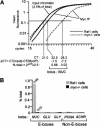
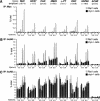
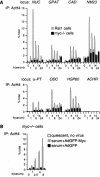
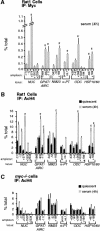

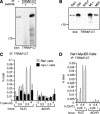
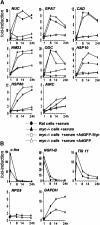
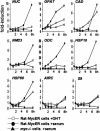
References
-
- Agalioti T, Lomvardas S, Parekh B, Yie J, Maniatis T, Thanos D. Ordered recruitment of chromatin modifying and general transcription factors to the IFN-β promoter. Cell. 2000;103:667–678. - PubMed
-
- Amati B, Frank SR, Donjerkovic D, Taubert S. Function of the c-Myc oncoprotein in chromatin remodeling and transcription. Biochim Biophys Acta. 2001;1471:M135–M145. - PubMed
-
- Aparicio OM. Characterization of proteins bound to chromatin by immunoprecipitation from whole-cell extracts. In: Ausubel FM, Brent R, Kingston RE, Moore DM, Seidman JG, Smith JA, Struhl K, editors. Current protocols in molecular biology. New York: John Wiley; 1999. pp. 21.23.21–21.23.12.
-
- Ayer DE, Eisenman RN. A switch from Myc:Max to Mad:Max heterocomplexes accompanies monocyte/macrophage differentiation. Genes & Dev. 1993;7:2110–2119. - PubMed
Publication types
MeSH terms
Substances
LinkOut - more resources
Full Text Sources
Other Literature Sources
Molecular Biology Databases
